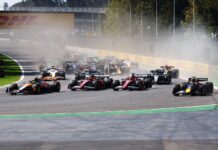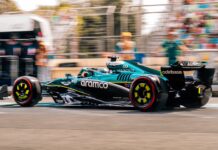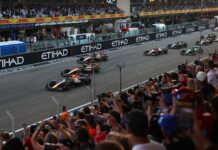The FIA has conveyed the decision of World Motor Sport Council with changes in F1 regulations for 2021 and beyond as confirmed which includes the budget cap and also aerodynamics cap.
Following reports from four days ago that F1 teams had approved an onslaught of regulatory changes in reaction to the catastrophic impact of COVID-19, it has been made official, after the FIA WMSC held an e-vote on Wednesday.
These modifications – some of which are in direct response to COVID-19, and some of which are to be implemented for other reasons – come on top of previously-made decisions to delay the technical regulations one season, and have far-reaching implications, altering the technical regulations, sporting regulations, and financial regulations.
The major things to note include a restrictive aerodynamic specification of the floor ahead of the rear tyes, to limit excessive development in that area, as well as an overhaul of previously-lopsided money distribution, and a parts freeze from F1 2020 to 2021, which had been discussed previously.
As what has been reported, the F1 budget cap will fall to $145 million for 2021 which was supposed to be $175 million. It will be decreased by $5 million in 2022 to $140 million and a further $5 million to be $135 million for 2022 until 2025 – based on 21 races.
The FIA has put down some special exclusions to the lowered F1 cost cap which can be found below, while it has confirmed about Notional Values for Transferable Components which will help the midfield teams buying parts from manufacturers’.
Moving on to the new aerodynamics limitations, the FIA has noted that it will kick-start from 2021 where the results of 2020 F1 season will be taken into account. As per the table, the winner will get to work at 90 percent rate, which will be followed in the order of 92.5, 95, 97.5, 100, 102.5, 105, 107.5, 110 and 112.5 (all in percentage).
For 2022 F1 season until 2025, it will be revised where winner will only work for 70 percent, with the rest in the order of 75, 80, 85, 90, 95, 100, 105, 110 and 115 (all in percentage). There is restrictions over power unit testing as well for manufacturers’.
Apart from this, the FIA notes that the tyres for 2020 F1 season will remain on in 2021 with 13-inches staying on, but should tyres supplier, Pirelli, wishes to introduce a new specifications, there will be testing allowed during free practice sessions.
In order to save further cost and as expected, the 2021 F1 season will see parts freeze from 2020, with things like suspension, chassis, gearbox and other mechanical parts not to be developed. The power unit upgrades will be limited as well.
Here’s the official statement from the FIA:
The World Motor Sport Council has approved by e-vote further changes to the Sporting, Technical and Financial Regulations governing the FIA Formula One World Championship primarily due to the ongoing need to reduce costs and safeguard the sport in light of the COVID-19 pandemic.
Following the initial agreement to postpone the 2021 Technical Regulations to 2022 (which was approved by the World Council on 30 March 2020), additional amendments to the Sporting, Technical and Financial Regulations for 2020, 2021 and 2022 have received unanimous support amongst the Formula 1 teams and were ratified today by the World Council.
The following is a summary of these changes:
Technical Regulations:
- Freezing of a large list of components between 2020 and 2021. The list includes the chassis, gearbox, a number of mechanical components and impact structures. A token system has been devised to permit a very limited number of modifications in accordance to the competitors’ specific needs.
- For 2020, limitations to Power Unit upgrades.
- For 2021, changes to the plan-view trim and simplification of the floor ahead of the rear tyres in order to moderate the increase of downforce between 2020 and 2021.
- For 2021, minimum mass increase to 749kg.
Sporting Regulations:
- For 2020, provisions for “closed” and “open” events and the relevant regulatory structure for each (e.g. personnel at the paddock), depending on whether such events permit spectators.
- For 2020, various updates relating to tyre regulations, with provisions to allow for tyre testing during Free Practice 2 should it be necessary to approve a new tyre specification by Pirelli and the extended use of P140 tyres in the case of a wet Free Practice 1 session.
- For 2020, a reduction in aerodynamic testing (ATR) and the introduction of Power Unit test bench restrictions for cost reasons.
- For 2021, a further reduction in aerodynamic testing, and the introduction of a bias between championship position and ATR limitations. The ATR bias will be linear between P1 and P10.
- For 2022, a number of key specific aspects of the regulations have been set out, including curfews, restricted number components (RNCs), scrutineering, and parc fermé prescriptions. These regulations work as a package together with the 2022 Technical Regulations that were approved by the World Council on 30 March 2020 and will be part of an ongoing review and refinement process throughout 2020 and 2021.
2021 Financial Regulations:
- Reduction of the Cost Cap level to $145M for 2021, $140M for 2022 and $135M for 2023-2025, based on a 21-Competition season.
- The following amendments/additions will be made to the exclusions currently provided for in the Financial Regulations:
- Increase of Year-End Bonus exclusion cap for exceptional sporting results from $10M to $12M and Social Charges for Year-End Bonus.
- Threshold for calculation of exclusion for Social Charges on Salary paid to staff lowered from 15% to 13.8%.
- Costs incurred for staff entertainment (capped at $1M).
- Wellbeing of employees: exclusion of costs incurred for medical programs (e.g. vaccination, eye tests, hearing tests) made available to all relevant employees.
- Sustainability costs incurred for environmental initiatives.
- Maternity/paternity/shared parental/adoption leave, exclusion for Salary costs.
- Sick leave and long term sick leave: exclusion for Salary costs.
- Projects undertaken to assist the FIA.
- Concurrently with these regulation changes, the Notional Values for Transferable Components (TRCs) have been defined by the FIA for 2021, which is of increased importance considering the reduced Cost Cap level. It has been reaffirmed that the concept of the Notional Values (subject to their correct and fair setting), achieves the following:
- Enables smaller teams to avoid the necessity to establish and maintain a capability to design, develop and manufacture the parts that have been designated as TRCs (Transferable Components)
- Prevents project “flipping” (a small team supplying a big one to circumvent the Cost Cap restrictions).
- Enables small teams to make genuine savings.
Here are the revised 2020 Technical Regulations: 2020 Formula 1 Technical Regulations – 27/05/20
Here are the revised 2021 Technical Regulations: 2021 Formula 1 Technical Regulations – 27/05/20
Here are the revised 2020 Sporting Regulations: 2020 Formula 1 Sporting Regulations – 27/05/20
Here are the revised 2021 Sporting Regulations: 2021 Formula 1 Sporting Regulations – 27/05/20
Here are the revised 2022 Sporting Regulations: 2022 Formula 1 Sporting Regulations – 27/05/20
Here are the revised 2021 Financial Regulations: 2021 Formula 1 Financial Regulations – 27/05/20
Here’s McLaren on job cuts
Here’s latest on F1 budget cap



















